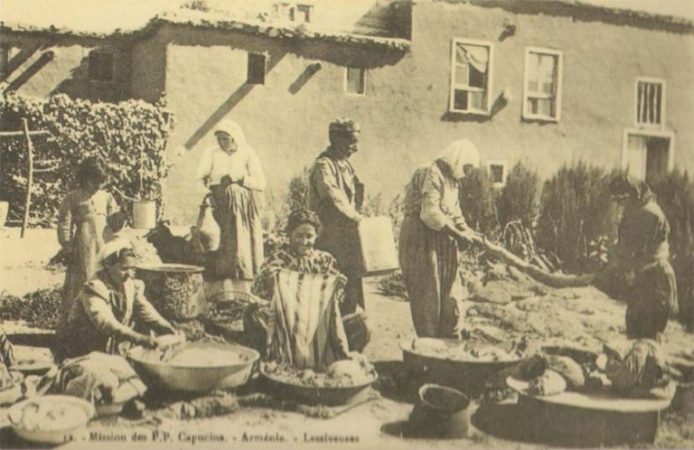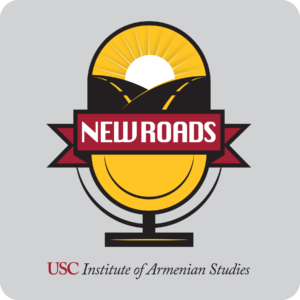
Installation Open at USC Doheny Library
August 28 – December 18
Peer into lost worlds represented by vintage Armenian postcards in 3D dioramas, juxtaposed with full-scale murals of contemporary images
THE USC INSTITUTE OF ARMENIAN STUDIES presents a one-of-a-kind installation of extremely rare postcards from Anatolia, displayed alongside scenes from many of the same locations captured a century later.
“Undeliverable: Postcards and Photos of Lives Interrupted,” which runs August 28 through December 18 in USC’s Edward L. Doheny Jr. Memorial Library, revolves around 160 original printed sepia tones, some of which have never been exhibited before, hand-picked from the world’s largest collection of Ottoman postcards. Illustrating the everyday lives of Armenians in cities, towns and villages, these pictorial souvenirs would be banal had their subjects not been exterminated by near-total genocide.
Collected over 32 years by Istanbul-based businessman Orlando Carlo Calumeno, the 80,000 unique postcards, all printed between 1895 and 1921, belong to a larger collection of books, furnishings and printed ephemera documenting quotidian life in multicultural, multilingual, turn-of-the century Anatolia.
“The postcards are especially interesting artifacts to work with,” says exhibition co-curator Narineh Mirzaeian, a Los Angeles-based designer and architect. “They’re pre-genocide, but they foreshadow what is about to happen. Or they don’t foreshadow it, which feels even more stark.”
As a counterpoint to the vintage postcards, the installation features Brazilian photographer Norair Chahinian’s visual explorations into his own Armenian roots. Drawn from two books of his photography, Armenia (2008) and The Power of Emptiness (2012), they include images captured using an antique camera owned by Chahinian’s grandfather, an Anatolian refugee who operated a photo studio in Aleppo, Syria, before joining the Armenian diaspora in São Paulo.
Photography and photographic printing, notes the collector, Calumeno, were almost exclusively Armenian trades in Ottoman Turkey. Religious prohibitions against making graven images prevented Muslims from entering the profession until 1910, and it fell to Christians, particularly Armenians, to fill the vacuum.
Postcards, he says, “were what the Internet is today”—an easy, low-cost way to preserve a travel memory or to keep in touch with loved ones. “In those days, people received hundreds of postcards from friends everywhere,” Calumeno says. “Most were thrown away.”
Some postcards included in the “Undeliverable” installation depict world heritage sites along the Silk Road. Others document ordinary village life and mundane urban structures—a new factory wing, school building or orphanage. Missionaries used these to support fund-raising efforts.
Calumeno, who is Armenian on his mother’s side and Levantine-Italian on his father’s side, focuses his postcard collecting on Anatolia’s diverse minority communities: Assyrians, Jews, Greeks, Kurds and especially Armenians. “The greatness of Anatolia was that melting pot,” he says. “Now it has become a mono-cultural, mono-lingual environment.”
His favorite card—the first he ever purchased, at age 16—depicts Istanbul’s Hippodrome Square near Hagia Sophia, the cathedral-turned-mosque and a major tourist attraction. Curiously, on the back side, the sender had jotted down a home remedy for nursing mothers to prevent cracked nipples. The card is addressed, in swirling Armenian cursive, to the woman’s sister in Bursa.
“These postcards are very important,” says Calumeno. “Each one is a gateway to connect with the past—a glorious past where everybody called each other ‘my brother, my sister.’ You see these naïve people, not knowing what is going to happen in the future. In these images, they live happily forever.”
“Undeliverable” is presented on two floors, in multiple parts, spanning the Doheny Library’s Treasure Room, Rotunda and Arts Corridor.
Working closely with USC Institute of Armenian Studies director Salpi Ghazarian, 160 vintage postcards are displayed in vitrines on the ground level, alongside documentary-style black-and-white images taken by Chahinian in recent years.
But in the Treasure Room, the curator has taken an unconventional approach. Focusing on 10 of the most intriguing postcards, she has scanned, enlarged and optically separated the images, creating layered, three-dimensional dioramas. Standing at eye-level on tripods, each diorama box invites visitors to peer into a lost world through a time-bending tower viewer. On the surrounding walls and ceiling, Mirzaeian has splashed full-scale murals of Chahinian’s bleak architectural photography illustrating modern Anatolia’s abandoned spaces, including a dilapidated Armenian church dome looming overhead.
The installation design invites visitors to navigate the curated scenes at two scales, says Ghazarian—zooming in to study nuances of daily life brought to life in the postcard dioramas, and zooming back out to see the blight left in the wake of genocide.
“It’s this surreal emotional landscape where alienation meets nostalgia, what-if encounters why, and despair yields to an irrepressible urge to reconstruct and build upon the erased past,” she adds.
Genocide exhibitions typically focus on victims, notes Mirzaeian. This installation focuses on places.
“It’s a different approach to what was lost, and what has remained,” she says. “It goes beyond victimhood—all these feelings we slip into that are unproductive. It’s more about re-inhabiting these spaces through the persistent architectural details. Those imaginative realities are interesting because they beg a lot of productive questions. Anytime you can do that, it’s good.”
“We’re very pleased to be able to present this immersive installation, in a timeless, three-dimensional space, here in the Library. This is especially important because the library’s long hours (open ‘til 10 pm weeknights, ‘til 8 pm Fridays and Sundays, and 5 pm Saturdays) will make it easy for anyone who wants to spend time in this lost world to attend. Admission, of course, is free,” said Ghazarian.
DOHENY LIBRARY HOURS:
Monday through Thursday, 8 am-10 pm; Friday, 8 am-8 pm; Saturday, 9 am-5 pm; Sunday, 12 pm-8 pm.












